Fillable Generic Direct Deposit Form
The Generic Direct Deposit Authorization Form is a crucial document that allows individuals to authorize electronic deposits into their bank accounts. By completing this form, you ensure that your salary, benefits, or other payments are securely and conveniently deposited directly into your chosen financial institution. Understanding how to fill out this form correctly can simplify your financial transactions and enhance your banking experience.
Customize Generic Direct Deposit Here
